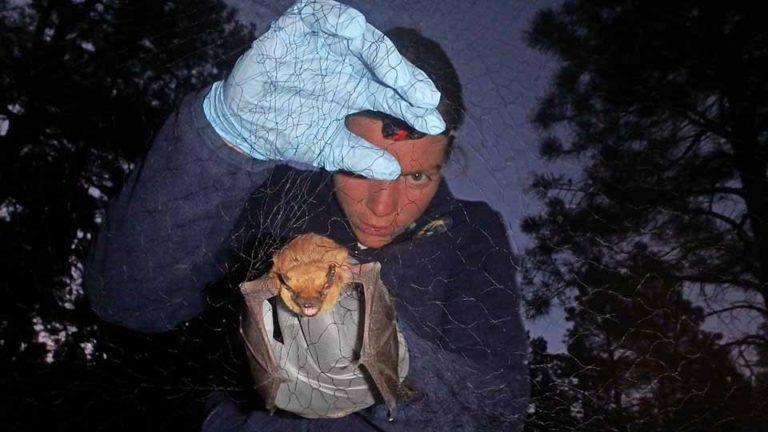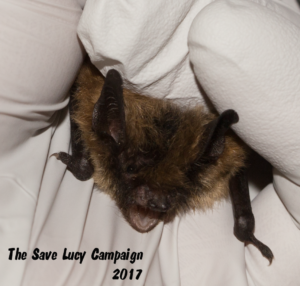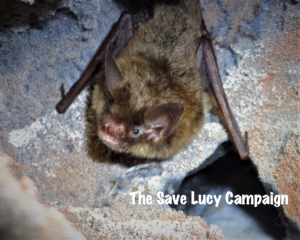
Hi everyone! I hope you all had a good week! I had a wonderful week full of holiday parties and cookies! Sadly though, I have some potentially unfortunate news. It appears that the Grand Canyon National Park has begun increasing…

Hi everyone! I hope you all had a good week! I went to Montreal for vacation! It was amazing. Montreal is a great city to visit and I highly recommend it. While I didn’t get to see lots of bats flying around at night, I know that Montreal has some cute ones. I decided to write this week’s blog on a little bat from Canada. The Eastern Small-footed bat is adorable! It is the smallest bat in North America and is only about 20 cm long with its wings stretched out. It has, as its name suggests, small feet. Their feet are less than half an inch long! Isn’t that adorable? They have brown fur with golden highlights, and a black furry face and ears. Their range is all the way from Virginia and West Virginia, into Pennsylvania, New York, and Canada. Even though they have a very big range, the Eastern Small-footed bat is the rarest bat in North America. One reason this species is threatened is because of problems with their roosts. They roost in caves, mines, and even under large rocks and other tight crevices. Many of their roosts are being disturbed while the bats are hibernating. Another serious problem these bats are facing is White Nose Syndrome. It is estimated that White Nose Syndrome has killed 12% of the species. When combined with other threats to the species, WNS is having a devastating affect on the Eastern Small-footed Bat. If you would like to read more about this bat, you can find information here.

Hi everyone! I hope you all had a good week. It was nice and relaxing. I wish it could be summer all year long! I found an article about the Northern Long-eared Bats in Wyoming. These bats are on the endangered species list and need all they help that they can get from bigger creatures like us. A group of bat researchers from the University of Wyoming drove out to the Black Hills in order to study these bats. This can be very difficult because bats are agile flyers and don’t like to be caught in nets. The bats aren’t hurt and are released as soon as they are fitted with transmitters. This study was important because the researchers are looking at where the bats live, and if any of them has come into contact with the fungus that causes White Nose Syndrome. In addition to the Northern Long-eared Bats they were there to study, researchers also found Western Small-footed, Little Brown, Big Brown, Hoary bats. One of the bats they found was a mother Northern Long-eared Bat. Luckily, White Nose Syndrome hasn’t been found in the area’s Northern Long-eared Bats, but it has been spotted less than 200 miles away in Fort Laramie, and Jewel Cave National Monument in South Dakota which is only 65 miles away. The researchers needed to study these bats because there is a logging team nearby. They were worried because the loggers are chopping down ponderosa pine trees, which are very important to the area’s Northern Long-eared Bats because they are used for maternity roosts. In order to make sure that the loggers don’t cut down any trees being used by the bats, researchers capture the mothers, glue trackers on their backs, and follow them back to their homes. The researchers were happy to […]
[ngg_images source=”galleries” container_ids=”5″ display_type=”photocrati-nextgen_basic_slideshow” gallery_width=”600″ gallery_height=”400″ cycle_effect=”fade” cycle_interval=”5″ show_thumbnail_link=”0″ thumbnail_link_text=”Bats of WNS” order_by=”sortorder” order_direction=”ASC” returns=”included” maximum_entity_count=”500″] The images above are white nose species we have hosted at Save Lucy. Not all species are imperiled equally, but all of them, even the more common ones, are in need of conservation action. — Ed. Hi everyone! I hope you all had a good week. Mine started off well because it was Easter. I like Easter! I got to eat a lot of candy and candy makes me happy. Sadly, my wonderful vacation and holiday had to come to an end. I went to school on Tuesday. I had to give a 10-minute speech in my English class on Wednesday. I also had exams. It was awful! Something else happened this week that was even more awful than my suffering. The fungus that causes White Nose Syndrome has been found in two new places. First, it was found in Kansas. Kansas is the 32nd state that the fungus has been found in. Several bats were found to have the disease in Cherokee County in Southeast Kansas and in Barber County in South central Kansas. This news made me very sad. As if that wasn’t bad enough, the fungus has now been found in Central Texas. It was found in the Panhandle of Texas last year and it seems to be spreading. It has now been found in 4 new Texas counties. They found the fungus on cave bats, tri-colored bats, Townsend’s big-eared bats, and on a Mexican free-tailed bat. The detection of the fungus on a Mexican free-tailed bat was particularly worrisome. Scientists don’t think these bats are susceptible to WNS, but since they migrate in such large numbers, they are worried the disease could spread further. If you would like to read […]
Hi everyone! I hope you all had a good week. I was sad on Thursday because it had snowed the night before, and I STILL HAD SCHOOL!!! There was at least half a millimeter of snow on the cars when I woke up in the morning. The sidewalks were damp. It was obvious to all Fairfax County Public School students that there should at least be a delay. I mean, they’ve cancelled school for less in the past. But, nothing! I had to go to school on time! The injustice of it all was overwhelming! Ok, I feel better now… I have some good news in the world of bats! Scientists might be on the verge of a breakthrough in eradicating White Nose Syndrome! As many of you know, the fungus most likely began in Eurasia, and the bats over there seem to be immune to it. The bats here in North America, however, are not. Little Brown bat populations have dropped 90 percent since White Nose Syndrome first appeared in New York. And, Tricolored and Northern-long Eared bat populations have dropped 97 percent. White Nose Syndrome even snuck its way west of the Rockies. There has been no news of any hope for a cure except for relying on time and evolution, until now. Hundreds of researchers have been trying for years to find a way to stop, or at least slow down, this deadly disease, with no luck. New research is beginning to show some hope of a solution. A study led by the U.S. Fish and Wildlife Service has been looking into the genomics of the fungus that causes White Nose Syndrome. They have discovered that this fungus is missing an enzyme that allows it to repair its DNA after it’s been exposed to UV light. They are […]
Hi everyone! I hope you all had a good week. I am now officially on winter break and I plan on enjoying myself immensely. I hope everyone else is able to enjoy their vacations and that you all have a wonderful holiday season. I read an article about researchers who are trying to find the origin of White Nose Syndrome. Scientists at Northern Arizona University and the U.S. Geological Survey’s National Wildlife Health Center used genomic sequencing to figure out where the fungus that causes the disease originally came from and how it is spreading. Up until now, there has been much speculation that the fungus originated somewhere in Europe or Asia. The scientists wanted to know its true origin, and hopefully gain some insight on how to stop it. By analyzing the genome of the fungus in samples from Europe, Asia, and North America, they found that there was a big difference between the fungus found on North America and the one in Europe and Asia. They discovered that there was a lot of diversity between the samples found in Europe and Asia, but almost none in North America. This helps prove the theory that the fungus was recently introduced to North America, and has been in Eurasia for much longer. One interesting fact is that the Eurasian bats have adapted and developed a resistance to the disease. This gives scientists hope that bats in the United States and Canada may be able to do the same. If you would like to read the article, you can find it here.


